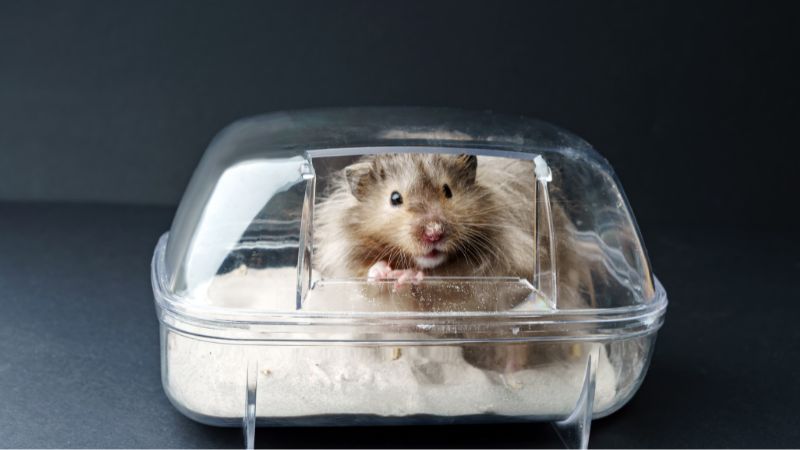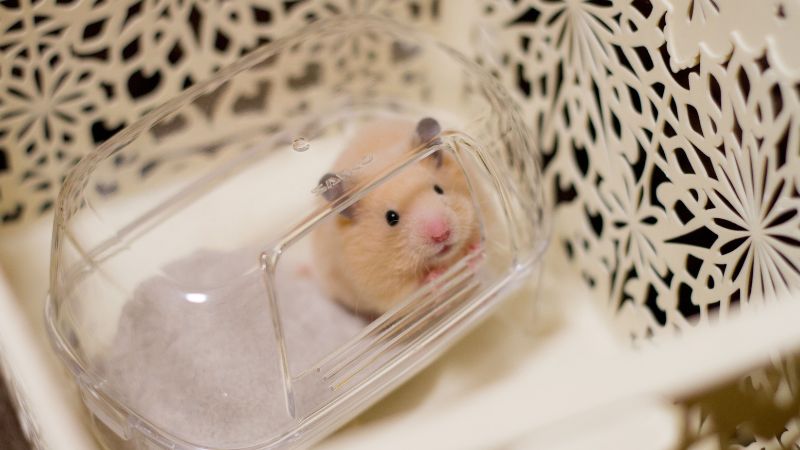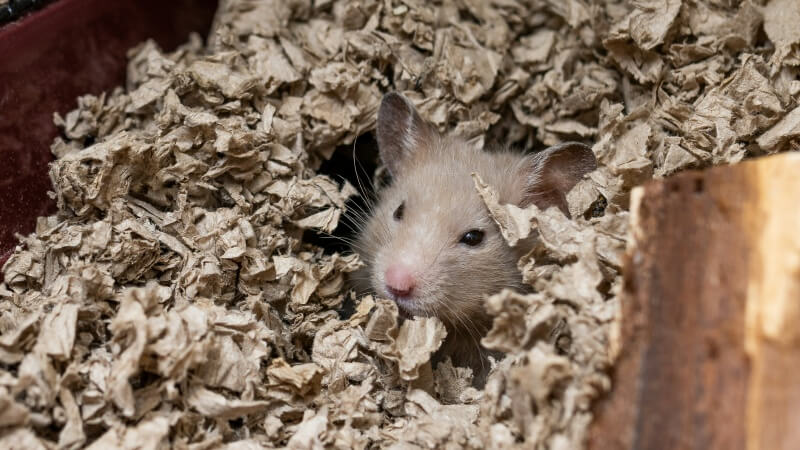
Can You Travel with a Hamster? A Comprehensive Guide
Traveling with a pet hamster isn’t as straightforward as it might seem. It requires careful consideration of your pet’s safety, comfort, and the logistics involved.

A sand bath is a very important part of a home for a dwarf hamster. Syrian hamsters also like sand (many enjoy playing in it!), but it’s especially important for dwarf types, like Roborovskis. I suggest having more than one sand bath!
Sand baths are easy to understand – dwarf hamsters roll in the sand to clean and remove oil from their fur. You might have seen some hamsters online that look oily or messy. This often happens when they don’t have a good sand bath to use.
Getting your hamster to start using a sand bath can be a simple and enjoyable process. Since hamsters naturally like to keep themselves clean, they often take to a sand bath quite easily.
Be Patient: Each hamster is different, and some might take longer to start using the sand bath regularly. Give them time to get used to this new part of their home.

First, let’s talk about what not to use: “bathing dust” and “calcium sand”.
Bathing Dust, often sold for chinchillas, is very powdery and can harm hamsters. They have sensitive breathing systems and tiny particles in the air can lead to respiratory infections. So, this dust is risky for your hamster.
Calcium sand, found in the reptile area, clumps when reptiles use it as a bathroom. After reading many reviews and discussions on reptile and hamster forums, it seems that calcium sand isn’t safe for hamsters or reptiles. It can cause blockages if eaten accidentally. There’s more info about this online.
But don’t worry, there are some good choices for your hamster!
The most cost-effective option is children’s play sand. You can buy it from local hardware stores, like Lowes or Home Depot.
You need to sift children’s play sand to get rid of big bits, then bake it to sterilize it. There’s a video by HammyLux that shows how to do this!
There are lots of good options for a sand bath container.
Some people use a clean shoe box, but I’ve noticed that cardboard boxes tend to leak sand. You’ll likely find sand everywhere when it’s time to clean.
Other folks prefer wooden boxes, which work well but they soak up hamster pee. Hamsters often use their sand bath, or a part of it, as a bathroom, so wooden containers can get spoiled over time.
Considering these problems, I recommend using something easy to clean, like acrylic, Pyrex, or glass.
Make sure the sand bath is at least an inch or two deep, so your hamster can have fun digging.
The bath should be as big as you can make it, especially for Roborovski or other dwarf hamsters. Alternatively, you could set up several sand baths of different shapes and sizes.
Same with the sand bath box in our wood hamster cage, the special sand baths are just for hamsters! The design of the sand bath is great because it keeps the sand away from the bedding, but still lets your hamster dig.
sand bath from Amazon:


Pyrex is a great choice for hamster baths because it’s available in various shapes and sizes, usually quite deep, and you can easily find it at thrift stores nearby! I’ve bought many Pyrex dishes for just a few dollars from local thrift stores. I love that they can go in the dishwasher and they look nice in my hamster’s cage.
A large glass baking dish doesn’t give as much depth for digging as a deeper sand bath would, but it offers plenty of space for a sand bath. You can fit a wheel, a hideout, and maybe another hideout all in the same sand bath!
I used a baking dish from Crystalia in my 75-gallon tank for my dwarf hamster, Julie. I prefer putting sand in the dish (rather than directly in the enclosure) so it’s easier to clean the dish and the sand occasionally.
Options from Amazon:
Always be careful when moving a sand bath because it can be heavy! I recommend removing your hamster from their enclosure before you try to move a sand bath to avoid accidents.
Acrylic trays are an excellent and convenient choice! I really like them because they’re very light and simple to manage. They also look fantastic!
Just a tip: don’t buy the ones with handles on the sides. Your hamster might try to squeeze through these holes and could get stuck!
If your sand bath isn’t on the ground inside the enclosure, I recommend getting a riser or platform. This prevents the sand bath from squashing your hamster if they dig underneath it (and they probably will!).
Alternatively, you could put your sand bath on a very stable shelf, like the type from Niteangel (available on Amazon), which is also shown below.
Adding adhesive cork to your riser or shelf helps keep the sand bath steady and stops it from sliding around.
Options from Amazon:
Hamsters enjoy feeling secure while they’re using their sand bath. If you decide not to buy a specialized hamster sand bath (like the ones from woodhamstercage.com that already come with covers), I recommend putting a few hideouts in your sand bath.
Since I have small dwarf hamsters, I use wide-mouth glass jars in their sand baths. These are perfect for little dwarves. They feel safe, and you can still see their cuteness!
My hamsters also tend to pee in these glass jars, making it easy for me to clean them. I just pop them in the dishwasher every few days and replace them with a new one.

For Syrian hamsters, a ceramic pot can be a better choice than a glass jar. They’re wider and safer for bigger hamsters. Just make sure to avoid pots with drainage holes – your hamster might try to squeeze through and get stuck! Planters from orchids or other gifted plants are great; I often reuse them in my hamster’s enclosure if I repot the plants or they don’t survive (I’m not great with orchids!).
A “cork flat” placed over the sand bath also looks natural and provides some cover. Steven, one of my Roborovski hamsters, loves his cork-flat cover, and I often find him underneath it.
Bendy bridges are another excellent choice for providing hiding spots in the sand bath.
Whatever you add, ensure it doesn’t have small holes or tiny handles at the bottom, as some ceramics do. Your hamster might try to go through these holes and could get stuck, which can be dangerous!
Dwarf hamsters especially spend a lot of time in their sand baths – sleeping, eating, grooming, and even using it as a bathroom! You should clean your hamster’s sand bath as often as necessary when it becomes dirty, or at the very least, at least once a week.
It’s advised to sift the sand once a week using a mesh sifter. This helps remove seed shells, clumps of sand soaked in pee, and other small debris.
Besides this, I personally prefer to wash the sand thoroughly every month or so, to make sure it’s really clean for them! There’s a video included below that talks about how to wash and dry sand for hamsters, used terrarium sand and children’s play sand.
Hamsters are great at cleaning themselves. But sometimes, they might need a bit of help.
A sand bath is a simple and fun method for your hamster to get rid of dirt.
To give your hamster a safe sand bath, use the right kind of sand and keep it clean.
Watch your hamster when they use the sand bath. If something seems wrong, call your vet.
Sand baths are really important for your hamster’s care. They help in many ways, like keeping your hamster clean and making sure they have fun and stay active. Here, you’ll find some easy-to-understand answers to common questions about sand baths. This will help you know why they are important and how you can use them for your pet hamster.
A: Syrian hamsters do not necessarily need sand baths but they can benefit from them. Sand baths help Syrian hamsters to keep their fur clean and healthy, and also provide them with mental stimulation and enjoyment. It’s a great addition to their grooming habits, especially since Syrian hamsters have long hair that can become matted if not properly groomed.
A: Yes, you can leave a sand bath in your hamster’s cage, but it’s important to place it in a quiet, low-traffic area to prevent it from tipping over. Also, monitor and clean the sand bath regularly, as hamsters love to use them as toilets. The sand should be changed frequently to prevent odors and bacteria buildup.
A: The frequency of sand baths depends on the individual needs of each hamster. Generally, Syrian hamsters might need one or two baths per month. However, if your hamster seems particularly dirty or spends a lot of time outside digging, more frequent baths may be beneficial.
A: The sand in the ham bath should be changed regularly, about every week or so, to keep it clean and hygienic. If the sand starts to smell or look dirty, it’s time to change it. Always use fresh, clean sand and avoid any sand that contains dyes, fragrances, or other harmful substances.


Traveling with a pet hamster isn’t as straightforward as it might seem. It requires careful consideration of your pet’s safety, comfort, and the logistics involved.

Finding the best hamster cage for Syrian hamster is crucial, as these curious, low-maintenance, and independent pets thrive in the right environment. The primary concern

When I began, the task of selecting essentials for a natural hamster habitat was daunting. To ease this process, I’ve assembled an exclusive set of

Have you ever wondered, “Are hamsters happier in bigger cages?” Generally YES. It’s a question that might seem straightforward, but there’s more to it than

Traveling with a pet hamster isn’t as straightforward as it might seem. It requires careful consideration of your pet’s safety, comfort, and the logistics involved.

Finding the best hamster cage for Syrian hamster is crucial, as these curious, low-maintenance, and independent pets thrive in the right environment. The primary concern

When I began, the task of selecting essentials for a natural hamster habitat was daunting. To ease this process, I’ve assembled an exclusive set of

Have you ever wondered, “Are hamsters happier in bigger cages?” Generally YES. It’s a question that might seem straightforward, but there’s more to it than
Copyright © 2025 woodhamstercage. All Rights Reserved.